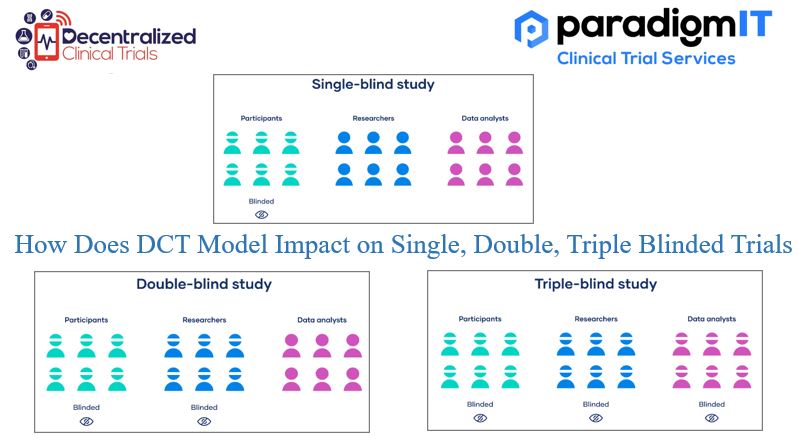A clinical trial model known as “decentralized clinical trial” (DCT) makes use of technology to conduct some components of the experiment remotely from locations other than conventional clinical sites. DCTs may offer several benefits over conventional clinical trials, including improved patient recruitment and retention, cheaper trial costs, and speedier trial completion dates. DCTs, however, also bring unique challenges, including worries about data security and privacy, adherence to the law, and potential limitations on access to technology for populations. The following are some possible effects of DCTs on certain trial types.
Single-blind trials: DCTs may make it simpler to blind the participant to the treatment they are receiving because the use of remote technology can assist in obscuring any observable variations between treatments that could otherwise be noticeable in a regular clinical environment.
Double-blind trials: In a double-blind study, neither the subject nor the researcher is aware of the participant’s current treatment. DCTs can make it more difficult to keep the researcher’s blindness intact because they may have access to information that could identify the treatment group. Digital tools, however, can be employed to guarantee that the investigator doesn’t have access to this data until the experiment is over.
Triple-blind trials: Triple-blind studies are research experiments where the treatment or intervention being studied is concealed from the research subject, the individuals administering the treatment, and the evaluators of the results, to reduce bias and ensure integrity. Decentralized triple-blind trials have decreased bias and increased the reliability and reproducibility of findings. However, they might be more difficult and expensive, requiring more precautions to keep blinding, and posing issues with data security and privacy. But they do present a potential strategy for running patient-centered clinical trials.
Planning and implementing procedures: For DCT (Decentralized Clinical Trial) studies can be challenging, but it is essential to ensure the integrity of the trial and the validity of the study results. Following are steps could be followed for planning and implementing the trial,
- Determine the appropriate type of study design.
- Develop clear procedures for study assessments & results that are blinded.
- Use appropriate technology to support blinding.
- Provide training to investigators and study staff to adopt the blinding procedure.
- Implement quality control measures to assess the effectiveness of blinding.
Technology supporting the blinding activities:
- Randomization and allocation of treatment groups (IRT): Use software platforms that allow for secure randomization and allocation of treatment groups to ensure that patients and investigators do not know which treatment is being administered. This can be particularly useful in double and triple-blinded studies, where maintaining blinding is critical to the validity of the study results.
- Validated Electronic data capture: EDC systems can be programmed to ensure that study personnel do not inadvertently reveal treatment information when entering data into the system.
- Remote monitoring of study activities: Use technology to remotely monitor study activities, such as patient visits and data collection, to ensure that study procedures are being followed correctly and that blinding is being maintained.
Example:
– Cloud-based data management systems: Cloud-based data management systems enable secure data storage and analysis while enabling PERMISSION based remote access to study data and real-time monitoring of data quality, completeness, and consistency only for authorized personnel but, not for blinded.
- Virtual patient visits: Use videoconferencing and other telemedicine technologies to conduct virtual patient visits and reduce the need for patients to visit a clinical site. This can help to increase patient accessibility and reduce the risk of accidental unblinding.
- Wearable devices: Use wearable devices to collect study data, such as activity levels or vital signs, and reduce the need for patients to visit a clinical site and data is manually entered. This can help to increase patient engagement and reduce the risk of accidental unblinding.
- Data analytics: Use advanced data analytics to detect potential unblinding events and take corrective action. For example, algorithms can be used to identify patterns in study data that suggest to verify the data that may lead to an risk of compromising blinding.
For more information –
Visit our website – www.paradigmit.com
Or you can write us at ask@paradigmit.com
Follow us for more – https://www.linkedin.com/company/paradigmittechnologyservices/?viewAsMember=true


